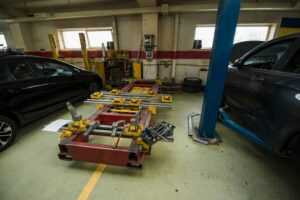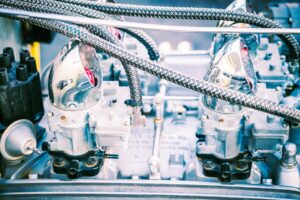 An engine test bed, also known as an engine dynamometer or an engine test rig, is a specialized facility used to test and evaluate the performance, efficiency, emissions, and durability of internal combustion engines. Here’s an overview of engine test beds:
An engine test bed, also known as an engine dynamometer or an engine test rig, is a specialized facility used to test and evaluate the performance, efficiency, emissions, and durability of internal combustion engines. Here’s an overview of engine test beds:
- Purpose:
- Engine test beds are designed to simulate real-world operating conditions and environments to assess the performance, reliability, and emissions characteristics of internal combustion engines.
- These tests help manufacturers, researchers, engineers, and quality control personnel validate engine designs, optimize parameters, diagnose issues, and ensure compliance with regulatory standards.
- Components:
- Engine: The engine under test is mounted on the test bed and connected to a dynamometer, which applies a load to simulate various operating conditions and loads.
- Load System: Test beds incorporate load devices, such as hydraulic or electric dynamometers, to simulate different load conditions encountered by the engine during operation.
- Measurement Instruments: Various sensors, meters, data acquisition systems, and analyzers are used to measure and record parameters such as torque, speed, power, fuel consumption, emissions, temperature, pressure, and vibration.
- Control System: Test beds are equipped with control systems, software, and interfaces that allow operators to set test parameters, control engine operation, adjust load conditions, and monitor performance in real-time.
- Fuel and Exhaust Systems: Test beds include fuel supply systems to provide fuel to the engine and exhaust systems to capture and analyze engine emissions during testing.
- Cooling System: Cooling systems are used to regulate the temperature of the engine and maintain optimal operating conditions during testing.
- Safety Features: Safety measures such as emergency stop buttons, protective enclosures, fire suppression systems, and exhaust ventilation are implemented to ensure operator safety and prevent damage to equipment.
- Types of Tests:
- Performance Testi
- ng: Performance tests assess the engine’s ability to deliver specified power output and torque under different load and speed conditions, including full load, part load, and transient conditions.
- Efficiency Testing: Efficiency tests measure the engine’s fuel consumption, thermal efficiency, and mechanical efficiency by comparing input energy (fuel) to output energy (mechanical power) under various operating conditions.
- Emissions Testing: Emissions tests measure the engine’s exhaust emissions of pollutants such as nitrogen oxides (NOx), carbon monoxide (CO), hydrocarbons (HC), particulate matter (PM), and greenhouse gases (CO2) to assess compliance with emission standards and regulations.
- Durability Testing: Durability tests subject the engine to prolonged operation under simulated real-world conditions to evaluate its reliability, robustness, and longevity over time.
- Cold Start Testing: Cold start tests assess the engine’s performance, emissions, and reliability during cold start-up conditions, including cold ambient temperatures and cold engine starts after prolonged periods of inactivity.
- Transient Testing: Transient tests evaluate the engine’s transient response and dynamic behavior during acceleration, deceleration, load changes, and other transient operating conditions.
- Fuel System Testing: Fuel system tests assess the engine’s fuel delivery, injection timing, and fuel system performance to optimize fuel efficiency, combustion quality, and emissions control.
- Benefits:
- Engine test beds provide valuable insights into engine performance, efficiency, emissions, and durability, enabling manufacturers to optimize designs, improve product quality, reduce emissions, and meet regulatory requirements.
- They facilitate research and development efforts to innovate new engine technologies, enhance combustion efficiency, develop advanced control strategies, and reduce environmental impact.
- Engine test beds help identify potential issues, defects, and performance limitations early in the development process, enabling corrective actions to be taken to minimize risks, warranty claims, and field failures.
In summary, engine test beds play a crucial role in the design, development, and validation of internal combustion engines, ensuring they meet performance, quality, emissions, and durability standards while delivering reliable and efficient power in various applications and environments.
Application Of Engine Test Bed:
- Automotive Industry: Engine test beds are extensively used in the automotive industry for testing and validating the performance of internal combustion engines used in passenger vehicles, trucks, buses, and motorcycles.
These test beds as - sess engine power output, torque characteristics, fuel efficiency, emissions, and durability under various operating conditions, helping manufacturers optimize engine designs and meet regulatory requirements.
- Aerospace and Defense: In the aerospace and defense sectors, engine test beds are employed for testing and evaluating aircraft engines, jet propulsion systems, and auxiliary power units (APUs).These test beds simulate flight conditions, assess engine performance, thrust output, fuel consumption, and reliability, ensuring safe and reliable operation of aircraft propulsion systems.
- Marine and Offshore Industry: Engine test beds play a crucial role in the marine and offshore sectors for testing and validating marine engines used in ships, boats, offshore platforms, and marine vessels.These test beds evaluate engine performance, power output, fuel efficiency, and emissions compliance under marine operating conditions, ensuring reliable propulsion and power generation at sea.
- Power Generation and Energy Sector: In the power generation and energy sector, engine test beds are utilized for testing and validating stationary engines used in generators, cogeneration systems, and distributed energy resources.These test beds assess engine performance, efficiency, and reliability, ensuring optimal operation and grid stability in power generation applications.
- Research and Development: Engine test beds serve as valuable tools for research institutions, universities, and engineering laboratories conducting studies on engine design, optimization, and performance enhancement.Researchers use test beds to investigate combustion processes, develop new engine technologies, and evaluate alternative fuels and emissions control strategies.
- Industrial Applications: Engine test beds find applications in various industrial sectors, including manufacturing, construction, agriculture, and mining, for testing and validating engines used in industrial machinery, equipment, and vehicles.These test beds assess engine performance, reliability, and durability, ensuring uninterrupted operation and productivity in industrial processes.
- Emergency Power Systems: Engine test beds are employed for testing emergency power systems, such as backup generators and standby power units, used in critical facilities, including hospitals, data centers, telecommunications facilities, and emergency response centers.
These test beds assess engine reliability, startup time, load response, and fuel efficiency, ensuring reliable backup power in emergency situations.

